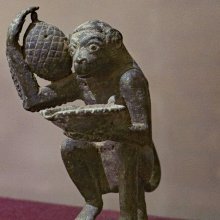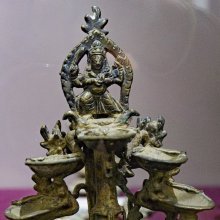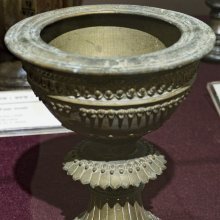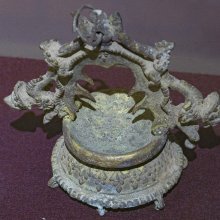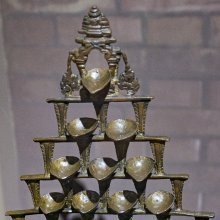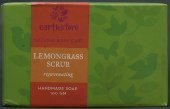Oil: 5 definitions
Introduction:
Oil means something in Hinduism, Sanskrit, Jainism, Prakrit. If you want to know the exact meaning, history, etymology or English translation of this term then check out the descriptions on this page. Add your comment or reference to a book if you want to contribute to this summary article.
Images (photo gallery)
(+27 more images available)
In Hinduism
Ayurveda (science of life)
Veterinary Medicine (The study and treatment of Animals)
Source: Asian Agri-History: Paśu Āyurvēda (Veterinary Medicine) in GaruḍapurāṇaOil (in Sanskrit: taila) is used in the various Anupāna (“drink take”), according to sections on the treatment of Horses (Gajāyurveda or Aśvāyurveda) in the Garuḍapurāṇa.—The Anupāna i.e. the drink take along with or after medicine was important in treatment. Because it may help in carrying, absorption, assimilation and enhancing action of the drugs. Normally the selection of anupāna is done depends upon disease, doṣa etc.—[...] In diseases of the deranged and aggravated vāyu the medicine should be administered through the taila (oil), or in combination with śarkarā (sugar), ājya/ghṛita (ghee) or toya (water).
Rasashastra (Alchemy and Herbo-Mineral preparations)
Source: History of Science in South Asia: Making Gems in Indian Alchemical LiteratureOil (in Sanskrit: Taila) is used in the Indian art of painting as well as coating stones for creating artificial gems such as Rubies, according to the Vādakhaṇḍa section of the Rasaratnākara (lit. “jewel mine of mercury”): a 13th century alchemical work in Sanskrit written by Nityanātha.—Oil can be used to create a glaze, providing both protection for the pigment and a sheen to the painting. Presumably, the idea in the Rasaratnākara’s ruby recipe was to give the imitation ruby an extra gleam. [...] The recipes after that just mention that the stones should be cooked as before, which could include their coating with oil, but may also not. Notably, the Garuḍapurāṇa (I.70.24) mentions appearing to be smeared with oil, or losing its lustre when rubbed as a sign of a fake ruby, pointing to a history of imitation jewels coated with oils.

Āyurveda (आयुर्वेद, ayurveda) is a branch of Indian science dealing with medicine, herbalism, taxology, anatomy, surgery, alchemy and related topics. Traditional practice of Āyurveda in ancient India dates back to at least the first millenium BC. Literature is commonly written in Sanskrit using various poetic metres.
Natyashastra (theatrics and dramaturgy)
Source: Shodhganga: Elements of Art and Architecture in the Trtiyakhanda of the Visnudharmottarapurana (natya)Oil (i.e., greasy substances) is associated with Catura-hasta: one of the twenty-two Single-hand Gestures (in Indian Dramas) (known as asaṃyuktahastas), according to the Viṣṇudharmottarapurāṇa, an ancient Sanskrit text which (being encyclopedic in nature) deals with a variety of cultural topics such as arts, architecture, music, grammar and astronomy.—According to the Viṣṇudharmottarapurāṇa, some colours are pointed with the catura hand gesture. [...] Instead of showing colours, in the Abhinayadarpaṇa, the caturahasta posture denotes some metals like gold, copper and iron. This posture also shows the application of some greasy substances like oil, ghee etc on the face

Natyashastra (नाट्यशास्त्र, nāṭyaśāstra) refers to both the ancient Indian tradition (shastra) of performing arts, (natya—theatrics, drama, dance, music), as well as the name of a Sanskrit work dealing with these subjects. It also teaches the rules for composing Dramatic plays (nataka), construction and performance of Theater, and Poetic works (kavya).
Shilpashastra (iconography)
Source: Shodhganga: Elements of Art and Architecture in the Trtiyakhanda of the Visnudharmottarapurana (shilpa)Oil represents one of the various substances used in the process of creating a Canvas, in the ancient Indian art of Painting (citra), according to the Viṣṇudharmottarapurāṇa, an ancient Sanskrit text which (being encyclopedic in nature) deals with a variety of cultural topics such as arts, architecture, music, grammar and astronomy.—Canvas is a kind of surface on which a painter can draw a picture. In ancient time walls are seen to be plastered with different substances (i.e., “oil”) and these were prepared for Painting. [...] For the process of plastering on a wall (i.e., kuḍya or bhitti), the painter needs to mix and mingle various ingredients [viz., oil, etc.]. After that, the mixture should be transferred to a touch stone mortar for the process of pounding.

Shilpashastra (शिल्पशास्त्र, śilpaśāstra) represents the ancient Indian science (shastra) of creative arts (shilpa) such as sculpture, iconography and painting. Closely related to Vastushastra (architecture), they often share the same literature.
In Jainism
General definition (in Jainism)
Source: The University of Sydney: A study of the Twelve ReflectionsOil (of a lamp) symbolically refers to asceticism, as discussed in Bhūdhardās’s composition dealing with the twelve reflections (bhāvanā or anuprekṣā), also found in the Tattvārtha-sūtra.—Accordingly, “[...] [the influx of karma]—Residents of the world wander forever in the sway of a delusional dream. On all sides the thieves of karma loot everyone but we pay no attention. (7) [blocking the influx of karma]—The true guru wakes us up when we are under the influence of the delusional dream. We can take his aid and stop the karma thieves. (8) The lamp of knowledge is full of the oil of asceticism. Study your home and put aside wandering. Thieves have already broken in, you can’t expel them without the rituals. (9) [...]”.

Jainism is an Indian religion of Dharma whose doctrine revolves around harmlessness (ahimsa) towards every living being. The two major branches (Digambara and Svetambara) of Jainism stimulate self-control (or, shramana, ‘self-reliance’) and spiritual development through a path of peace for the soul to progess to the ultimate goal.
See also (Relevant definitions)
Starts with: Crocodile oil, Fish oil, Hog oil, Oil cake tree, Oil lettuce, Oil of ben tree, Oil palm, Oil palm tree, Oilanu, Oilaunu, Oilbean tree, Oilman.
Ends with (+66): Ajowan oil, Alagarkoil, Arctic cinquefoil, Bean trefoil, Bearded cinquefoil, Benue oil, Bush cinquefoil, Cajeput oil, Canadian snakeroot oil, Castor oil, Chaulmoogra oil, Cinquefoil, Common cinquefoil, Creeping tick trefoil, Crocodile oil, Croton oil, Domba oil, Dumboil, Dwarf cinquefoil, Fish oil.
Full-text (+2653): Taila, Eranda, Pinyaka, Tailakara, Khali, Tilataila, Tailayantra, Mrakshana, Abhyanga, Sneha, Khandali, Ruvuka, Teli, Karpurataila, Sarshapataila, Snigdha, Tailabhyanga, Sarshapa, Snehapakva, Tailishala.
Relevant text
Search found 307 books and stories containing Oil; (plurals include: Oils). You can also click to the full overview containing English textual excerpts. Below are direct links for the most relevant articles:
Cosmetics, Costumes and Ornaments in Ancient India (by Remadevi. O.)
2.1. Pharmaceutical use of Oil < [Chapter 1 - Cosmetics]
3.2. Medicinal Baths < [Chapter 1 - Cosmetics]
9. Prohibition of Cosmetics < [Chapter 1 - Cosmetics]
The Garuda Purana (by Manmatha Nath Dutt)
Chapter CXCVII - Preparations of medicinal oils and Ghritas < [Dhanvantari Samhita]
Chapter CCXVII - Various Recipes for the cure of sterility, virile impotency, etc. < [Dhanvantari Samhita]
Chapter CCXIV - Medical treatment of snake-bite, etc. < [Dhanvantari Samhita]
Sushruta Samhita, volume 4: Cikitsasthana (by Kaviraj Kunja Lal Bhishagratna)
Chapter XXXI - The medicinal use of Sneha (oleaginous substances)
Chapter IV - The medical treatment of nervous disorders
Charaka Samhita (English translation) (by Shree Gulabkunverba Ayurvedic Society)
Chapter 27l - The section on the articles used in cooked foods (Aharayogi) < [Sutrasthana (Sutra Sthana) — General Principles]
Chapter 7 - The Appearance of the Diseased Patient (vyadhita-rupin) < [Vimanasthana (Vimana Sthana) — Section on Measure]
Chapter 28 - The therapeutics of Vata Diseases (vatavyadhi-cikitsa) < [Cikitsasthana (Cikitsa Sthana) — Section on Therapeutics]
Chaitanya Bhagavata (by Bhumipati Dāsa)
Verse 1.12.82 < [Chapter 12 - The Lord’s Wandering Throughout Navadvīpa]
Verse 2.102 < [Chapter 2 - The Lord’s Manifestation at the House of Śrīvāsa and the Inauguration of Saṅkīrtana]
Verse 3.6.17 < [Chapter 6 - The Glories of Śrī Nityānanda Prabhu]
Manusmriti with the Commentary of Medhatithi (by Ganganatha Jha)
Verse 5.24 < [Section V - Stale Food]
Verse 8.326-329 < [Section XLIII - Theft (steya)]
Verse 5.113 < [Section XIII - Purification of Substances]
Related products
(+712 more products available)
